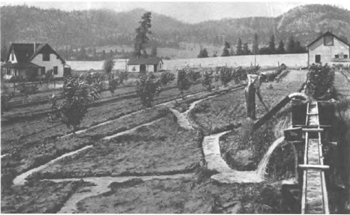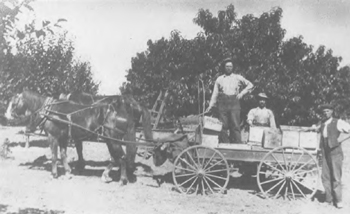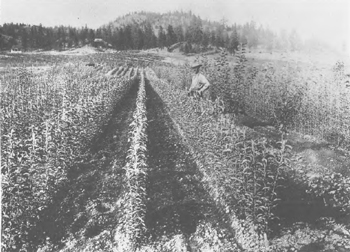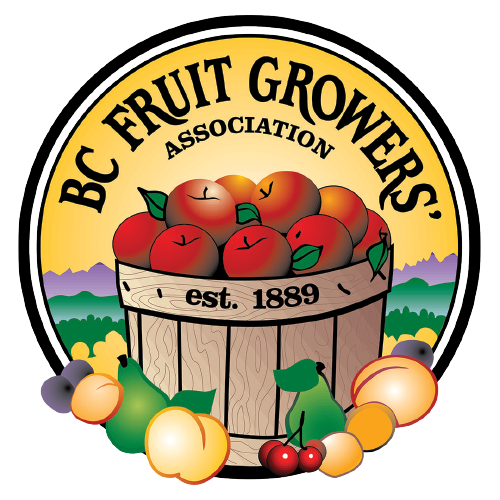Establishing the News B.C.F.G.A.
The expansion of fruit growing after the turn of the century had not been mirrored by a similar growth of the B.C.F.G.A. Indeed, by 1910 the membership had dropped to ninety-seven, and neither Kelowna nor Vernon, the two main centers of development, were represented at the annual meeting that February. A British Columbia Fruit-Growers’ Convention was held at Kamloops on April 12, 1910, for the purpose of reviving the B.C.F.G.A. and increasing its appeal to the new growers. This convention was charged with revising the constitution of the Association to bring it into line with the other provincial agricultural organizations under closer governmental sponsorship and direction. The Department of Agriculture had itself recently been reorganized, with separate branches established for horticulture and for livestock and dairying.

In preparation for the Convention, the Department of Agriculture had invited representatives from all the fruit growing areas. A committee consisting of the Deputy Minister of Agriculture, the Provincial Horticulturist, and the President of the B.C.F.G.A. had drawn up a proposed new constitution, which was discussed, amended, and adopted at the Kamloops Convention. The objects of the Association were now:
the advancement of horticulture in all its branches, particularly the promotion of a better knowledge on the part of all fruit-growers as to the marketing of our fruit, and to facilitate successful marketing by securing better conditions in packing, cooling, storage, transportation, and distribution; a.) By holding an annual convention for the consideration of problems affecting the industry.
b.) By collecting, arranging, and disseminating useful information, more particularly with regard to the marketing of our products:
c.) By co-operating with the Provincial Department of Agriculture in all matters, particularly educational, with reference to horticulture:
d.) By holding an annual exhibition of fruit and other horticultural products, and awarding premiums at the same, and by encouraging local societies along the same lines:
e.) And by other such means as may be desirable.
The main differences between this constitution and its predecessor were the focus on fruit and the emphasis on marketing.
Membership was open to “any person interested in horticulture”, at one dollar per year, with life memberships available for a single payment of ten dollars. Local fruit growers’ associations could affiliate at the rate of fifty cents per member. Directors were now to be selected on a geographical basis, one for each of sixteen horticultural divisions of the province, with provision for creating new divisions as new areas became active in fruit growing. The Executive of seven members was dominated by the Government, since the Minister and Deputy Minister of Agriculture were ex officio members, and the Secretary-Treasurer, although it was not directly stated so, was a permanent official of the Department of Agriculture lent on a part-time basis for the job. (This position was initially held by R.M. Winslow, the Provincial Horticulturist).

Reorganization bore immediate fruit. By the time of the 1911 Convention, membership had increased to 259, seven affiliated organizations sent delegates to the convention, and the government grant was raised to $2500. The general tack the reorganized B.C.F.G.A. would take was stated in the Executive Report:
There has been some comment as to the advisability of developing the Association to serve fruitgrowers better in the line of technical information on the culture of fruit. Because of the greatly increased efficiency of the Department of Agriculture in the past few years, it is felt that this work with the individual grower need not occupy time or energy of the Association. . . . In the matter, however, of remedying Province-wide conditions, detrimental to the general progress of the industry, and especially with regard to transportation and marketing conditions, which . . . affect fruit-growers as a whole and which must be dealt with by an organization of their own, . . . the Executive has worked to make the Association of value.

The 1911 Convention kept to tradition by holding lengthy discussions on freight rates and conditions, once again debating standardized fruit package dimensions, and calling for higher tariffs on imported fruit. The Provincial Government was called upon to alleviate the shortage of labour by encouraging immigration from the British Isles by means of publicity and assisted passages.
By the time of the 1912 Convention, membership had again doubled to 594 including fifteen affiliated associations. Membership continued to rise to 696 two years later. The government grant was increased to $3500 in 1912 and to $6500 in 1913. In practice the government saw the B.C.F.G.A. as an adjunct to the Department of Agriculture and used it as part of its policy of building the province through agricultural settlement.







